|
Exercise Physiology Laboratory |
Exercise Protocol |
| |
In the laboratory, several sessions of three minutes of
stepping predetermined cadences based on the age and gender of the
subject will be performed, as implemented in the modified Canadian
Aerobic Fitness Test (mCAFT).
The heart
rate at the end of each stepping stage is recorded (the subject wears a
Polar heart monitor).
The subject
continues to the next stage if the attained heart rate is under 85% of
predicted (predicted maximum heart rate = 220—age).
At the start of the second minute of each stage, the subject breathes
through a Spirometer for 20 seconds, such that tidal volume and
breathing frequency can be recorded and minute ventilation can be
calculated.
VO2Max is estimated, and oxygen cost and caloric
expenditure for that exercise is calculated.
|
|
The modified
Canadian Aerobic Fitness Test (mCAFT)
|
|
|
The Canadian Society for Exercise
Physiology has published "The Canadian Physical Activity,
Fitness & Lifestyle Approach", which details fitness assessment
protocols. One such protocol, the mCAFT, is designed to give
information about the aerobic fitness of a person, while using
minimal equipment. The subject works by lifting its own body
weight up and down double steps (40.6 cm in height total) while
listening to set cadences from a compact disc. The end-stage of
the age and gender specific stepping rate requires 85% of the
age-predicted maximum heart rate. The heart rate increases
approximately in a linear fashion from 50% to 100% of maximal
oxygen intake. The heart rate does not decrease significantly
during the first fifteen seconds of recovery. Thus, one can
predict an aerobic fitness using the heart rate right after
exercise of a known sub-maximal rate of working. |
|
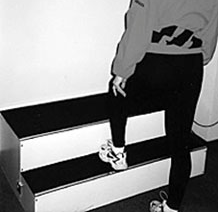 |
|
Starting stepping stage by
gender |
| Age |
Males |
Females |
| 15-19 |
4 |
3 |
| 20-29 |
4 |
3 |
|
Oxygen cost in ml/kg/min |
| Stage |
Stepping cadence
(Females) |
Stepping cadence
(Males) |
oxygen cost
(Females) |
Oxygen cost
(Males) |
| 3 |
102 |
102 |
22 |
22 |
| 4 |
114 |
114 |
24.5 |
24.5 |
| 5 |
120 |
132 |
26.3 |
29.5 |
| 6 |
132 |
144 |
29.5 |
33.6 |
| 7 |
118 |
132 |
36.2 |
40.1 |
|
|
Stepping routine |
|
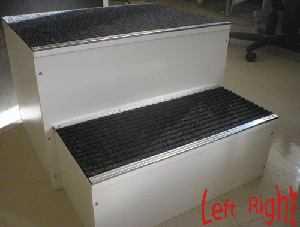 |
The subject is standing facing the steps |
|
Step- step up |
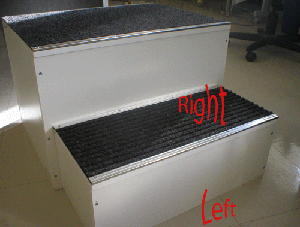
Place right foot on first step |

Place left foot on second step |

Place right foot on second step so feet are together |
|
|
Step- step down |
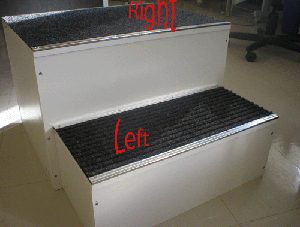
Start down with your left foot to the first step |
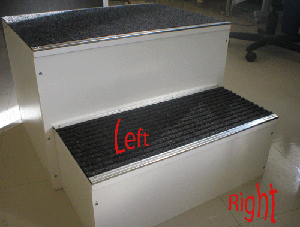
Place right foot on ground level |
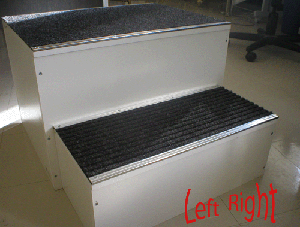
Place your left foot on ground so feet are together |
|
|
Each stepping session lasts for three
minutes. At the beginning of the second minute of each stage, the
individual will breathe for 20 seconds to record tidal volume and
breathing frequency and calculate minute ventilation. |
|
Pneumotachometry |
- Refer to the pneumotachometry
section of the respiratory lab (other experiments) to view the setup
used to record the tidal volume.
- The subject must wear a nose clip while breathing into the
flowhead.
- A fresh mouthpiece is used. The
mouthpiece must be placed inside the mouth so that only the tube
part shows.
|
|
Heart rate monitoring |
A Polar (www.polar.fi)
heart rate monitor (belt and watch) is used to measure heart rate
continuously. A transmitter belt is fastened around the chest while the
watch is held by a nearby observer. If at any time during the experiment
the heart rate exceeds the predetermined ceiling (85% of age-predicted
max heart rate) the experiment should be stopped immediately.
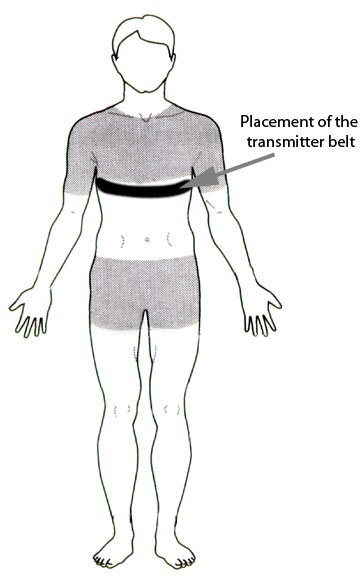 |
|
Blood pressure measurement |
|
Systolic and diastolic blood pressures are
recorded using an automated sphygmomanometer before starting the first
workload and at 2 minutes and at 5 minutes post recovery. |
|
Calculations |
|
|
The predicted VO2Max is derived
from this equation*: 17.2 +
(1.29 x oxygen cost at the final stage) - (0.09 x weight in kg) - (0.18
x age in years)
* Weller et al. Prediction of maximal
oxygen uptake from a modified Canadian aerobic fitness test. Can. J.
Appl. Physiol. 18(2) 175-188, 1993
*Weller et al. A study to validate the
Canadian aerobic fitness test. Can. J. Appl. Physiol. 20(2) 211-221,
1995
|
|
|
|
|
|
|
|
|
|
|